It is the ultimate question for Burgundy fans seeking wines for drinking – with prices of the region’s best having risen so high, where can one find value?
Wine Lister’s second Burgundy study published in collaboration with regional specialist, Jasper Morris, notes the proliferation of good value wines hailing from some of the lesser-known appellations, and even outside of the Côte d’Or (Saint-Aubin, Marsannay, Mercurey, and Pouilly-Fuissé were among those mentioned).
Below Wine Lister explores some of the wines worth snapping up from the 2019 campaign*, based on their relative value when compared with other wines in their sought-after appellations. 37 out of the 58 wines listed in charts below are white.

Chablis – a permanent alternative source for Burgundy drinking white outside of the Côte de Beaune – features heavily. Buzz brands William Fèvre and Billaud-Simon achieve multiple entries, as does the Chablis estate of Maison Albert Bichot – Long-Depaquit, and relative newcomer to the cream of the crop, Jean-Paul et Benoît Droin. This group of top Chablis achieves an average price of £52 in bond per bottle, while their Côte de Beaune counterparts cost more than 30% more for the same quality (since both groups achieve an average WL score of 93).
Among the Côte de Beaune whites, Alain Chavy’s Puligny-Montrachet Folatières, and Fontainte-Gagnard’s Chassagne-Montrachet Caillerets provide the best quality-to-price ratios, both achieving WL scores of 94, for £48 and £53 per bottle in-bond respectively. Domaine Rapet’s Corton-Charlemagne provides excellent value for Grand Cru white (considering that the appellation’s reference – Jean-François Coche-Dury – typically costs over £3,000 per bottle).

Only one Grand Cru red makes the cut in top-scorers under £100 per bottle – Georges Lignier’s Clos Saint-Denis.
In the rest of the Côte de Nuits, strong value propositions hail from Taupenot-Merme throughout, particularly its Morey-Saint-Denis La Riotte. Maison Louis Jadot and Heresztyn-Mazzini achieve multiple entries in Gevrey, and the Nuits-Saint-Georges appellation makes an appearance across three producers – Grivot, Faiveley, and Henri Gouges.
The average price difference between the reds of both Côtes is not so dramatic as for Chablis and its Beaune counterparts. Côte de Beaune reds as shown the image above reach an average price of £72, just 10% lower than the Côte de Nuits group (for the same average WL score of 92). Domaine de Montille takes three of the eight places for its Corton Clos du Roi, Volnay Taillepieds, and Pommard Pézerolles.
*N.B. prices are based on those aggregated through Wine Lister’s pricing partner, Wine Owners. Not all Burgundy 2019s have recorded prices as yet, so the above lists may well evolve over the coming weeks and months.
The last lot of Burgundy 2019 scores are in, from Wine Lister’s regional specialist critic, Jasper Morris (Inside Burgundy).
Below we explore Jasper’s top scores by Burgundy “subset”, as defined in Wine Lister’s recent study on the region (recap its key findings here).
While no wines earned perfect scores this year, Jasper’s highest score was in fact awarded to a Premier Cru performing beyond its classification – Arnoux-Lachaux’s Vosne-Romanée Aux Reignots. He notes that the wine is “completely heartbreakingly suave and sensational”, offering “crisply ripe cherries, alpine strawberry, the lightest raspberry touch, then a generous pure clear long finish”.
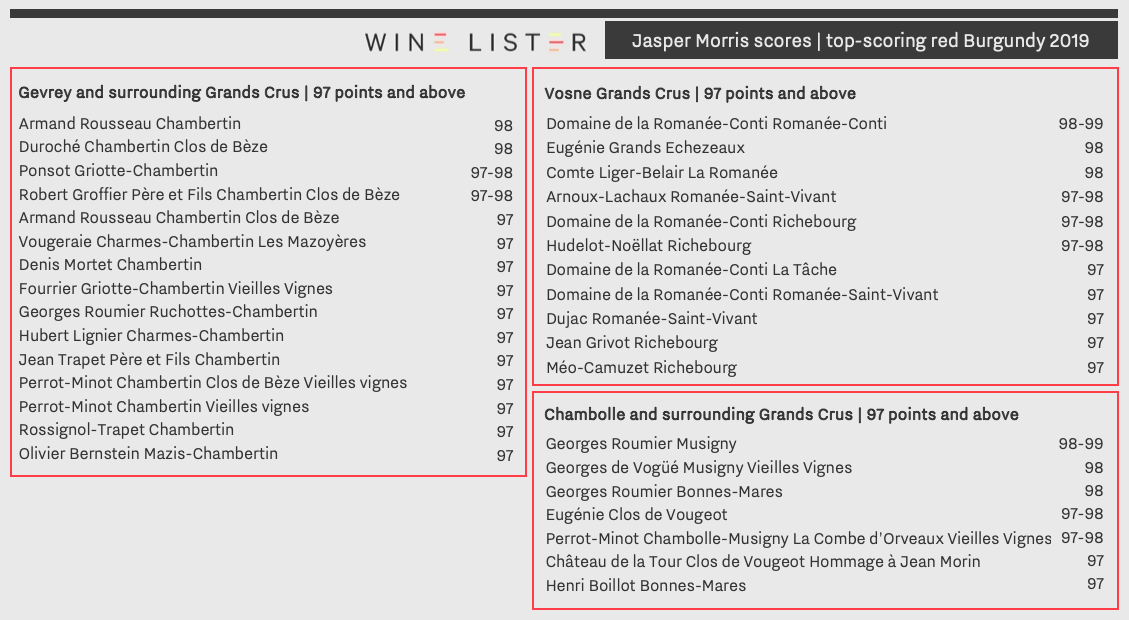
In Gevrey and its surrounding Grands Crus areas, Armand Rousseau fares well, its Chambertin and Chambertin Clos de Bèze earning scores of 98 and 97 respectively. Up-and-comer Domaine Duroché ties for first place within the subset with its Chambertin Clos de Bèze. Jasper describes it as having “a little lick of oak, which is entirely in place, a light, but fresh acidity, a sense of harmony throughout and a deepening of the fruit on the second half of the palate”, creating a “glorious conclusion”.
Georges Roumier proves king of Chambolle and its surrounding Grands Crus, earning two places among the top scorers for the domaine’s Musigny and Bonnes-Mares. Adding testament to the improving quality of maisons de négoce (as mentioned in Wine Lister’s Burgundy study), Maison Henri Boillot makes an appearance among the top ranks for its own Bonnes-Mares.
Domaine de la Romanée-Conti understandably dominates the Vosne Grands Crus category, though star producer Arnoux-Lachaux features among the top 11, in addition to its high-scoring Vosne-Romanée Premiers Crus. Speaking to Wine Lister following the completion of his Burgundy 2019 reports, Jasper notes that Arnoux-Lachaux has “unequivocally joined the greats with a faultless array of stunning wines in 2019, hitting heights of ethereal elegance without sacrificing power”.
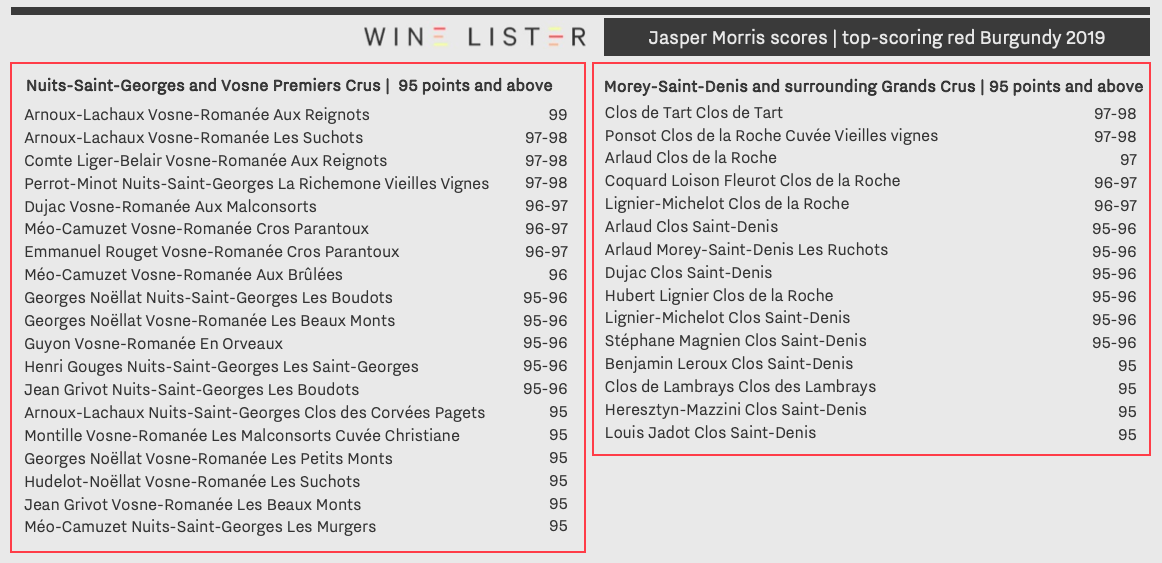
Jasper reports that Morey-Saint-Denis has done well in 2019, as “the village which had the benefit of the best rainfall figures in August”. He adds, “not only are Clos des Lambrays and Clos de Tart progressing well under their new ownerships and winemakers, but class acts such as Domaine Dujac and Christophe Perrot-Minot have filled their boots, while Domaine Arlaud have produced their best set of wines ever”.
Interestingly, no Côte de Beaune red scores above 96 from Jasper in 2019 (though the top scorer at 95-96 points is Méo-Camuzet’s Corton Rognet). See all top scores for Côte de Beaune reds in 2019 here.
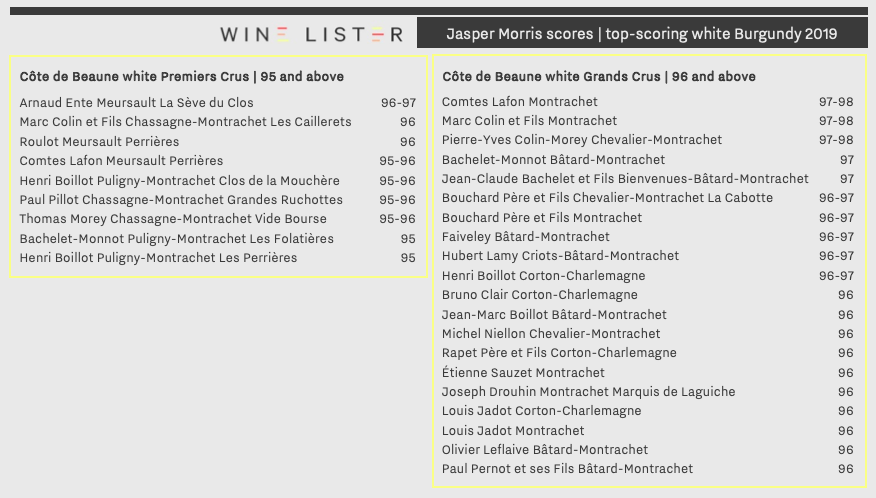
Whites in 2019 do not reach the dizzy score heights of their red counterparts. The above chart therefore takes into account Côte de Beaune white Premiers Crus with scores above 95, and Côte de Beaune Grands Crus achieving 96 points or above.
In the latter subset, maisons de négoce Bouchard Père et Fils and Maison Jadot achieve two entries apiece, for their Chevalier-Montrachet La Cabotte and Montrachet, and Corton-Charlemagne and Montrachet respectively.
Producers Bachelet-Monnot, Comtes Lafon, Domaine Henri Boillot, and Marc Colin also all appear twice in the top Côte de Beaune white rankings for 2019.
View more Burgundy 2019 scores here. Wine Lister Pro users can search and filter by critic scores, and can view all of Jasper Morris’ top Burgundy 2019 scores here. Click here to find out more about the Pro subscription.
Though Wine Lister are missing what would have been London’s Bourgogne tasting week this week, our partner critic, Jancis Robinson, has now released the majority of her scores for the 2019 vintage, providing a better picture of the top en primeur picks.
Explore all Burgundy 2019 scores here, or read more below.
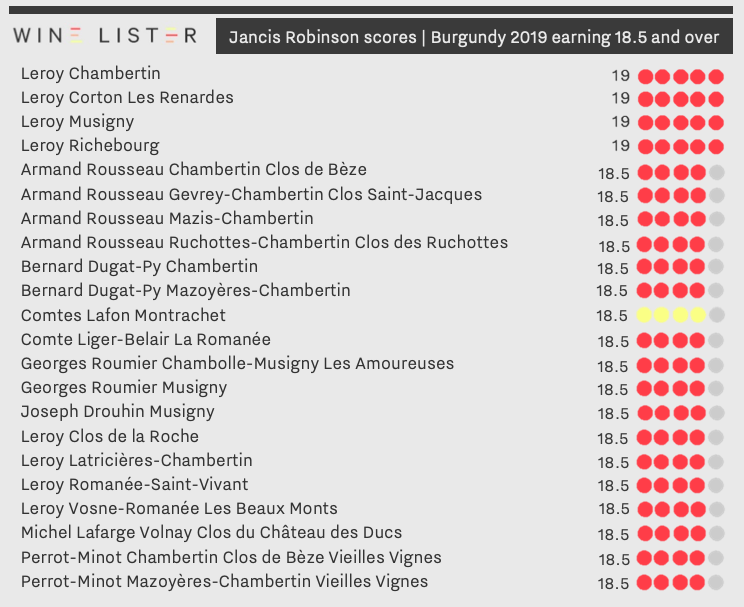
A drought year resulting in wines of extreme concentration, yet balanced by energising acidity (recap Wine Lister’s report on Burgundy’s 2019 vintage here), there are 22 Burgundy 2019s that have so far been given a score of 18.5 or above.
Jancis awarded 19 points to Leroy’s Chambertin, Corton Les Renardes, Musigny, and Richebourg, after having not published any scores for Leroy since the 2013 vintage. The property fares extremely well in 2019, occupying eight places in the list of 22 wines earning 18.5 and over. Leroy’s Clos de la Roche, Latricières-Chambertin, Romanée-Saint-Vivant, and Vosne Romanéee Les Beaux Monts all achieve a score of 18.5.
Armand Rousseau occupies four places in the list, with its Chambertin Clos de Bèze, Gevrey-Chambertin Clos Saint-Jacques, Mazis-Chambertin, and Ruchottes-Chambertin Clos des Ruchottes all earning 18.5 points. While slightly down on her ratings for the property’s 2018 offerings (she awarded 19 points to Rousseau’s Clos de la Roche and Ruchottes-Chambertin Clos des Ruchottes in 2018, and a further 18.5 points to its Chambertin, Chambertin Clos de Bèze, and Gevrey-Chambertin Clos Saint-Jacques), it nonetheless continues its excellent quality performance in 2019.
Comtes Lafon’s 2019 Montrachet is the only white Burgundy to gain a score of 18.5 from Jancis Robinson so far, continuing its series of top scores awarded by the critic in recent years. She describes it as “Both rich and savoury. Not remotely fat but with massive intensity. Throbbing and jewel-like”, concluding that “Dominique [Lafon] must be thrilled by this”.
Also featured on the list of Burgundy 2019s earning 18.5 and over from Wine Lister partner critic, Jancis Robinson are: Bernard Dugat-Py Chambertin, Bernard Dugat-Py Mazoyères-Chambertin, Comte Liger-Belair La Romanée, Georges (or Christophe) Roumier Chambolle-Musigny Les Amoureuses, Georges (or Christophe) Roumier Musigny, Joseph Drouhin Musigny, Michel Lafarge Volnay Clos du Château des Ducs, Perrot-Minot Chambertin Clos de Bèze Vieilles Vignes, and Perrot-Minot Mazoyères-Chambertin Vieilles Vignes.
View more Burgundy 2019 scores (including those of Jasper Morris and Neal Martin) here.
The first of the Burgundy 2019 en primeur releases began this month, reigniting conversation of last year’s growing season, and its subsequent offerings. Wine Lister has spoken to several key Burgundy producers, and has sampled the 2019s from leading négociant, Louis Jadot, to get a better picture of this promising vintage.
Burgundy’s 2019 growing season was marked by a notably hot and dry summer, resulting in wines of extreme concentration. Due to a combination of spring frost, uneven flowering, and summer drought across many sites, yields in 2019 are significantly lower than average.
 A line-up from Louis Jadot’s 2019 en primeur tasting, organised by Hatch Mansfield at Vagabond, Monument on the 3rd of November 2020
A line-up from Louis Jadot’s 2019 en primeur tasting, organised by Hatch Mansfield at Vagabond, Monument on the 3rd of November 2020
Sourcing grapes from across the region, including its own holdings in some of Burgundy’s most prized plots (e.g. Chapelle Chambertin, Clos Vougeot, and Vosne-Romanée), Louis Jadot’s production in 2019 is down 50% for Chardonnay, and 30% for Pinot Noir. A cool and windy spring caused millerandage across Jadot’s sites, leading to many of the smaller, unripe berries being discarded. Warm temperatures in 2019 meant that grapes had high natural sugar levels, and correspondingly high alcohol across the region. Deputy General Manager, Thibault Gagey, tells us that several Louis Jadot wines are approaching 14 degrees in 2019, however, they nonetheless offer “good acidity, so they are powerful but balanced”, and there “isn’t a feeling of high alcohol”.
Wine Lister agrees whole-heartedly, and was particularly impressed by the quality of the whites. The Chablis Blanchot was “pure and lithe with an already-sumptuous texture”, while the Chassagne Montrachet Morgeot Clos de la Chapelle offered a delightful nose of “honey, truffle, and brioche”, with “rich citrus” on the palate. For reds, Wine Lister enjoyed the “complex and earth-toned” Clos Saint-Denis, and the “powerful but poised” Gevrey-Chambertin Clos Saint-Jacques. Gagey informs us that he is indeed “very proud of the 2019s”, and is “confident that it will be a good vintage”.
Across the Côte de Beaune, harvests were small in 2019. Arnaud Ente tells us that his namesake domaine saw “a spell of spring frost”, which caused significant damage and loss of yield, and “uneven weather patterns during flowering”, caused coulure and millerandage. The summer was mostly hot and dry, causing hydraulic stress to the vines, but “20-30mm of rainfall in late August” helped to unblock phenolic maturation, and allow the grapes to reach “impressive levels of maturity while maintaining good sugar levels, and also a very lovely acidity”. Ente notes that his 2019s have achieved “extraordinary balance, due to the acidity in the grapes developing slowly”. The vintage is of “enormous potential”, if down 20% on an average year in terms of volume.
Domaine Jean-Noël Gagnard similarly experienced significant frost in 2019; the principal cause of its small harvest. Winemaker Caroline Lestimé echoes the experience of “millerandage followed by hydraulic stress on the vines during the summer drought”, resulting in “small, but thankfully exceedingly concentrated berries”. Due to the two extremes of conditions throughout the season, Lestimé analysed the sugar / acid balance frequently near to harvest, so as to pick the optimum window for picking. Once again, quality here is likely a triumph, but Lestimé adds that “Jean-Noël Gagnard has not seen such a small harvest since 1999”.
Guillaume d’Angerville tells us that in Volnay, “frost risk was on everyone’s mind”, however, “dry and windy conditions helped to avoid frost damage” across Marquis d’Angerville’s plots. Water and heat stress in summer was a problem here too, “stopping the plant’s evolution, and veraison was delayed as a result”. He similarly explains that “selecting the correct harvest date proved difficult”, in part due to the “heterogenous grape maturation”, however in the end, “the entire range benefitted from the perfect maturity of the grapes”, despite yields being down 20-30% on the average year. He tells us that his 2019s are “succulent and full of energy”, without being “jammy” from such a hot year, and therefore providing “another successful vintage ending in 9”.
Akin to Louis Jadot, Winemaker Jean-Nicolas Méo tells us that Méo-Camuzet’s 2019s are “well-ripened”, with “fairly high alcohol levels, around 14 degrees”. He states that there is nonetheless “a nice acidity to start”, which provides the wines “a good freshness and a certain structure”, as well as lengthy ageing capacity. Echoing d’Angerville’s sentiment on the success of 9s, Méo foresees “an evolution of this vintage like the 2009: rich and greedy at first, then gradually closing, to emerge in a decade more tense and structured than suggested today”.
Despite the significantly reduced volumes in 2019, the quality of Burgundy’s latest vintage release clearly suggests a long and promising future ahead. The combination of these two factors will surely see demand outweigh supply for en primeur once again. For more guidance on buying Burgundy 2019 en primeur, and essential analysis to inform your wider Burgundy investment decisions, purchase our in-depth Burgundy study here.
Before the bulk of Burgundy en primeur 2019s are released onto the market, Wine Lister has published its second in-depth Burgundy study.
Below we explore the complex relationship between the region’s price performance and its popularity growth over the past two years, informing your investment decisions over the coming months.
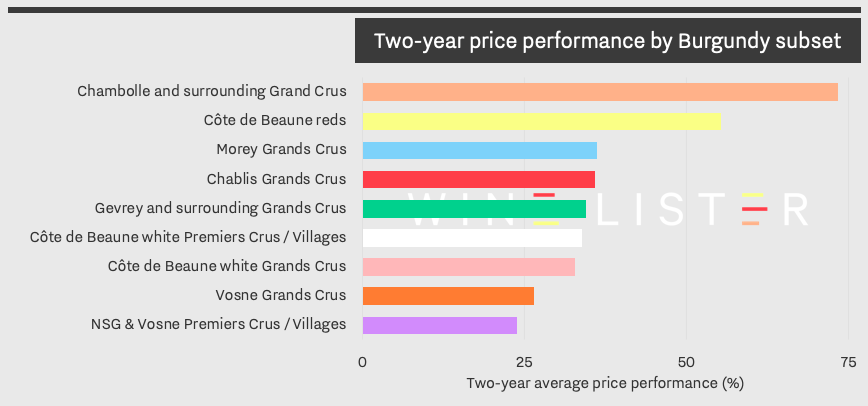 The two-year price performance of a basket of 175 Burgundy wines (the same wines featured in our previous study on the region in 2018), based on the last 30 vintages. Price data partner: Wine Owners.
The two-year price performance of a basket of 175 Burgundy wines (the same wines featured in our previous study on the region in 2018), based on the last 30 vintages. Price data partner: Wine Owners.
As shown in the chart above, Chambolle and its surrounding sites lead in the price performance of Burgundy Grand Crus, followed by wines hailing from its northerly neighbour, Morey-Saint-Denis. The notorious sub-set of Grand Crus from around Vosne – home of legendary Richebourg, La Tâche, Echezeaux, and Romanée-Conti – has seen slower price performance, which is matched with lower popularity growth (see below).
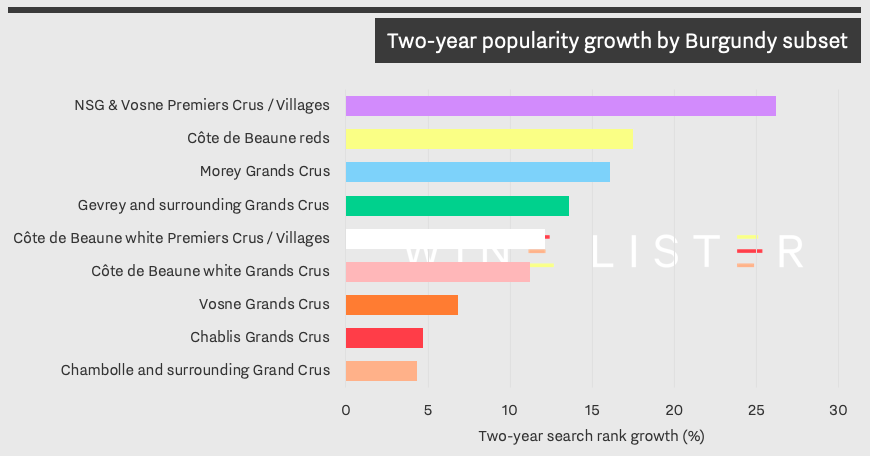 The two-year popularity growth of each Burgundy subset. Popularity data partner: Wine-Searcher.
The two-year popularity growth of each Burgundy subset. Popularity data partner: Wine-Searcher.
Though Chambolle and its surrounding Grand Crus have excelled in two-year price growth, consumer interest in the wines of this subset increased the least. Following similarly this opposing relationship between the two data sets, Nuits-Saint-Georges / Vosne Premiers Crus and Village wines gained the most popularity over the last two years by a large margin, while the subset’s price performance trails behind in last place.
A growing interest in lower-priced wines from Burgundy is further explored through trends identified by key members of the international fine wine trade in Wine Lister’s report. Producers such as Arnoux-Lachaux and Georges Mugneret-Gibourg are well worth looking out for when buying Burgundy en primeur for drinking in several years’ time.
Visit the Analysis page to purchase Wine Lister’s in-depth 2020 Burgundy study, or download it using your Pro subscription here (available in both English and French).
“Finché c’è vino c’è speranza” – As long as there is wine, there is hope.
Never before have Italian winegrowers been able to dedicate as much time to the care of their vineyards as in 2020. The Consorzio Vino Chianti Classico and several further Tuscan producers cite this silver lining to Covid restrictions, and they suspect it will reveal itself in the wine to come. In a year that has caused tribulation across the world, news of Italy’s promising 2020 harvest is certainly welcomed. Wine Lister has spoken to several Italian estates, which reportedly yielded high-quality grapes across the board. While regions – Piedmont and Tuscany – had their respective weather nuances, the general consensus suggests that growing season conditions were balanced, with no mention of hail or storms.
In Montalcino, the Mastrojanni team explained that lockdown prompted improved vineyard inspection in 2020: “[people] couldn’t work indoors in their offices, so the vines received the utmost attention”. They report a “very good harvest” this year, comparing it to the high-scoring 2013. Despite two short heatwaves in July and August, the estate had a mild summer overall, thanks to cooling winds that flow through the Amiata Valley in which its vineyards are situated.
On the other side of Montalcino, Cinelli Colombini reported frost during budburst, which limited the number of grape clusters in 2020. Several other Tuscan producers spoke of reduced volumes due to the cold start to spring (Fattoria Le Pupille’s 2020 yield is 20% lower than last year). Cinelli Colombini’s Brunello grape harvest was nonetheless of “excellent quality”, and despite it being hard to “shine after a masterpiece of a vintage like 2019”, the team believes it will be “difficult to exclude it from being among the best five vintages of the last 20 years”.
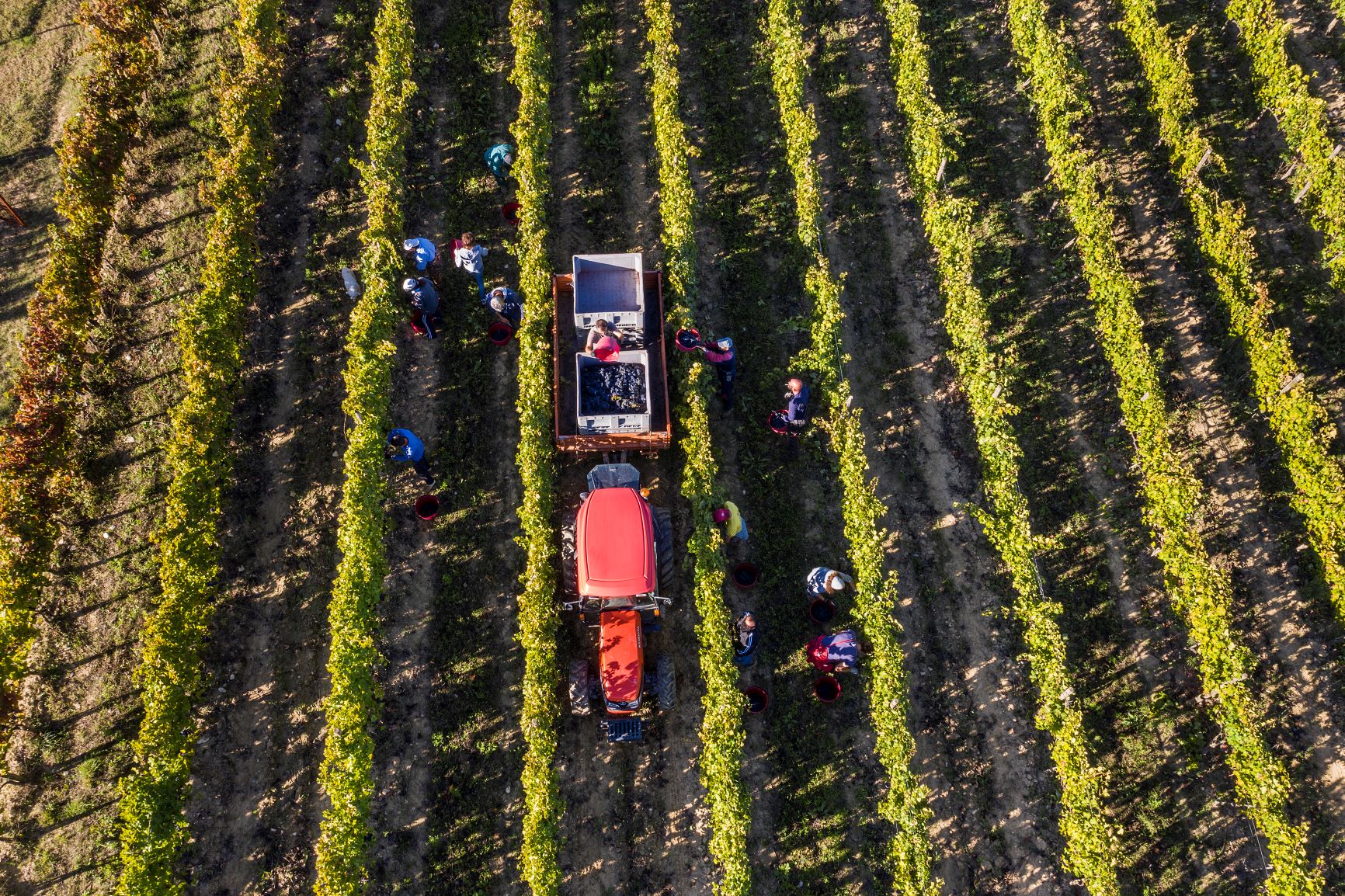 All hands on deck: the 2020 Brunello harvest at Montalcino’s Cinelli Colombini
All hands on deck: the 2020 Brunello harvest at Montalcino’s Cinelli Colombini
In Chianti, Castello di Monsanto began picking its Chardonnay grapes on 8th September, and collected its final Sangiovese on 10th October. Third-generation owner, Laura Bianchi, informed us that their spring was mild, with enough rain to create a “perfect” reserve of water for the vines. After the hot and dry August, a wet start to September helped to regulate maturation – a common theme throughout Tuscany in 2020. The grapes thus developed a “great balance of sugar, pH, and phenolic maturation”, and the first fermentation already suggests a vintage of “great personality, rich tannins, and beautiful acidity”. Further east, Vecchie Terre di Montefili started picking on 29th September – late in comparison to other producers, but normal, the team explains, for their vineyards, which lie 500 metres above sea level (and therefore require a longer maturation period).
Less than an hour away, Brancaia finished its harvest on 30th September (having started on the 3rd week of August). The team tells us that they were forced to harvest their Sangiovese quickly before heavy rain arrived, but that they were lucky that the grapes were “the perfect grade of ripeness”. In contrast, IPSUS owner, Giovanni Mazzei, explains that he and winemaker Gionata Pulignani decided to wait until after the extra rain in September before starting the harvest, “to guarantee more balance, extra aromatics, and temper the alcohol content”. In doing so, the hot and dry summer was counterbalanced; Mazzei states that he could indeed “classify the [2020] as a good compromise between cooler and hotter vintages”.
In coastal Maremma, owner and Production Manager at Fattoria Le Pupille, Ettore Rizzi, tells us that 2020 saw a significant threat of powdery mildew across its vines, especially in the thin-skinned varieties of Sangiovese, Ciliegiolo, and Syrah. He states that they nonetheless managed to trim the affected bunches and stem the problem, while their Merlot and Cabernet vines also “gave us some incredible fruit”. According to Rizzi, “the word that can best describe the 2020 vintage is concentration” – a consequence of the high temperatures in July and August.
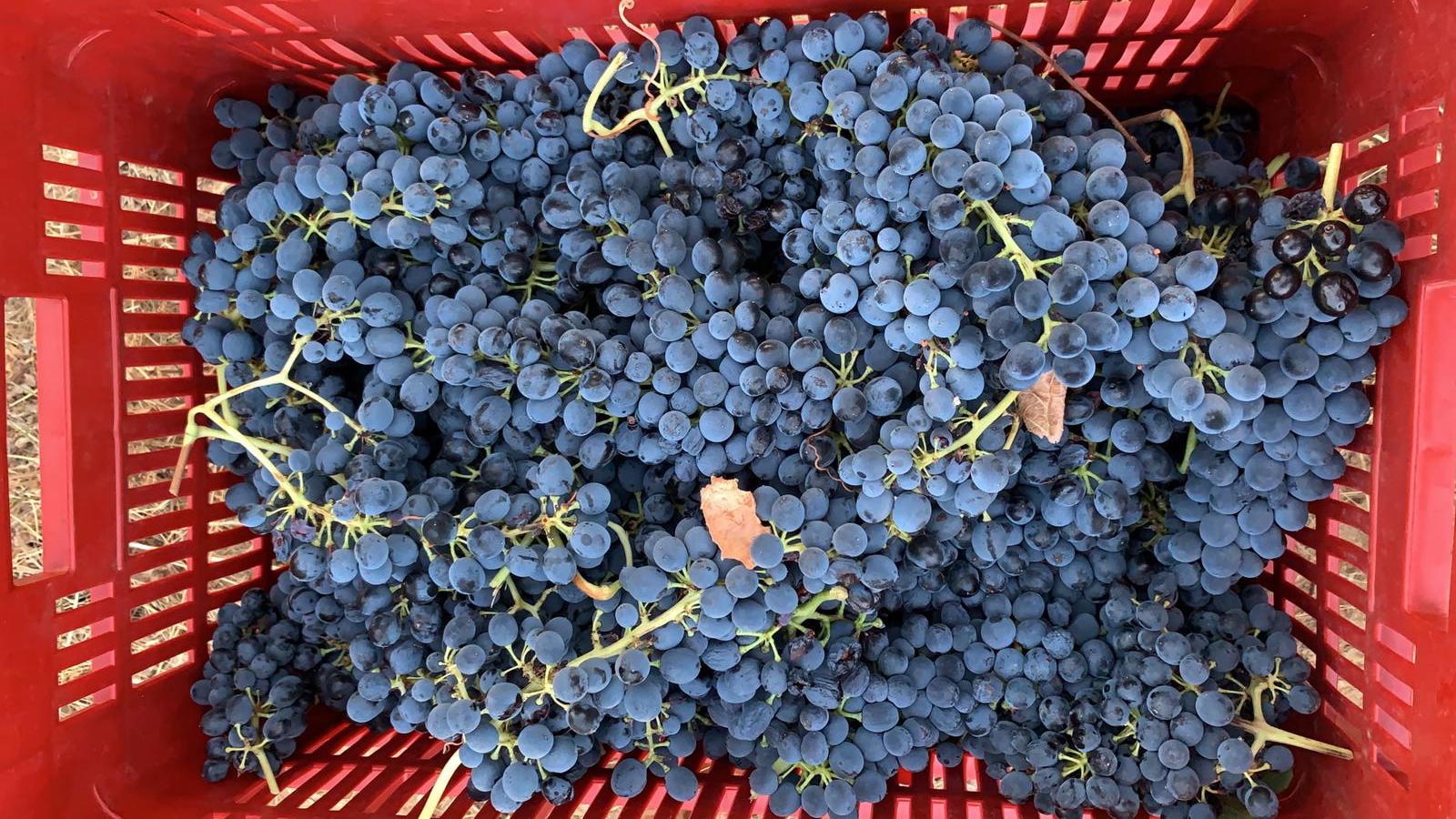 “The final quality of the grapes was really good” – Fattoria Le Pupille’s 2020 Syrah grapes
“The final quality of the grapes was really good” – Fattoria Le Pupille’s 2020 Syrah grapes
In Bolgheri, Ornellaia’s Estate Director, Axel Heinz, declared that their 2020 vintage is “shaping up to be one to remember as a great year”. The property saw “textbook perfect conditions until the end of May”, while June saw a lot of rainfall that “accelerated vine growth”, and required lots of work in the vineyard to keep the canopies under control. Summer saw hot and dry conditions, while rain arrived in the last days of August to alleviate drought stress and lower temperatures, encouraging a more even ripening at the last moment. While an unexpected mid-September heatwave made it necessary to pick all three red varieties – Cabernet Franc, Cabernet Sauvignon, and Petit Verdot – simultaneously at speed, Heinz notes that they nonetheless look “very promising in a rich and structured style”.
Moving up to Piedmont, fifth-generation of the esteemed Gaja family, Giovanni Gaja, tells us that they are so far “optimistic” about the 2020 vintage, despite it being early days to evaluate the exact character of the grapes. Their Barbaresco plots witnessed a moderate July, followed by a warm August that was similarly alleviated by rain towards the end of the month. While they required extra efforts to prevent mildew attacks, the final picked grapes appear “very healthy”.
While 2020 has caused much uncertainty, the recent harvest suggests that there is definitely hope for some excellent wine to come from this year, and we look forward to finding out for ourselves in the future.
Taittinger Comtes de Champagne 2008 was released yesterday (1st October) at c.£89 (per bottle in-bond), marking one of the last 2008s from the “Grandes Maisons” to enter the market. The release has reignited discussion on the success of the vintage in Champagne, which has been declared one of the best of the decade along with 2002. Below we investigate top 2008s, and where the latest addition from Taittinger fits within them.
Characterised by a consistent, dry, and cool growing season, climatic conditions in 2008 encouraged slow veraison across Champagne, which enabled grapes to achieve their full phenolic maturity while retaining acidity. The combination of both gives the vintage considerable ageing potential, and unyielding structural integrity.
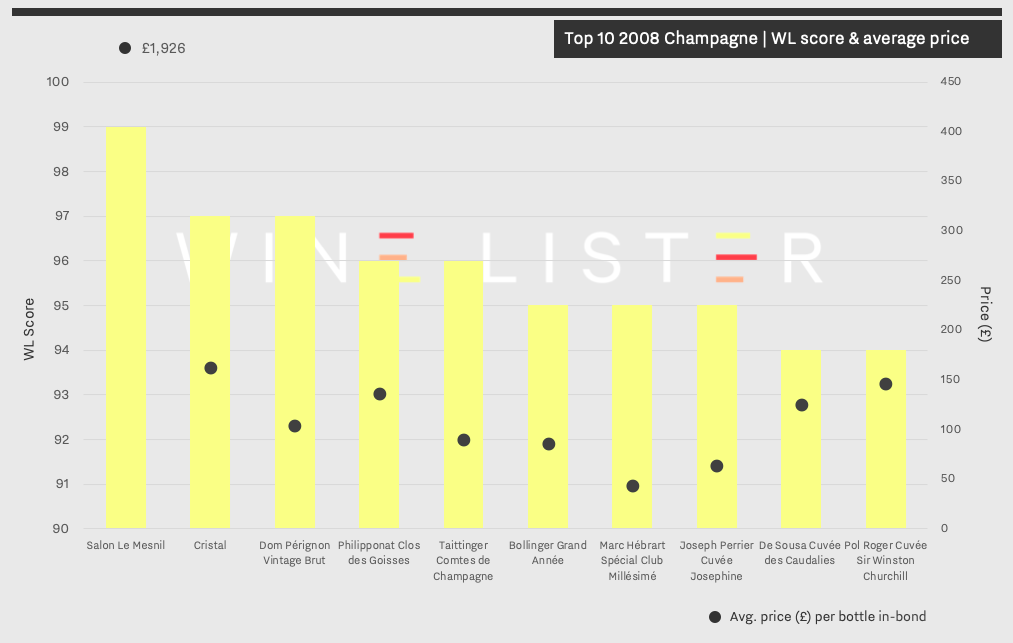
As illustrated above, the top 10 2008 champagnes by WL score exhibit impressive quality, with the top three wines gaining scores of 97 and above. This has not been achieved in the past four vintages, with Krug Brut Vintage 2003 being the most recent back vintage of a champagne to achieve a WL score of 97. Indeed, the top 10 champagnes gain an average WL score of 95.8 in 2008, compared to an average of 94.6 across the top 10 champagnes from the previous vintage.
The newest addition to the top 10 haul, Taittinger Comtes 2008 shows good value within the wider context of the vintage, despite entering the market at a 26% premium on the current market price of its 2007 vintage. While achieving the same WL score as MUST BUY Philipponat Clos des Goisses 2008 (96), Taittinger’s latest release is available for 34% less, (£89 vs. £135 per bottle in-bond). Similarly, it achieves one more WL point than Bollinger Grand Année 2008 (available for £85 per bottle in-bond), for a very slight premium.
Wine Lister partner critic, Antonio Galloni awards Taittinger Comtes de Champagne 2008 98+ points, stating it “is simply breathtaking” and “represents the purest essence of the Côtes des Blancs in a great, historic vintage”. He concludes, “readers who can find the 2008 should not hesitate”.
Taittinger Comtes de Champagne is historically one of the top 10 most liquid champagne brands, giving it further investment appeal. Additionally, Taittinger announced that it has not produced any 2009, 2010, or 2011 Comtes de Champagne, due to poor weather conditions during these years – a fact that may well increase interest in this latest release.
Also featured in the list of top 10 2008 Champagnes by WL score are: Salon Le Mesnil, Cristal, Dom Pérignon Vintage Brut, Marc Hébrart Spécial Club Millésimé, Joseph Perrier Cuvée Josephine, De Sousa Cuvée des Caudalies, and Pol Roger Cuvée Sir Winston Churchill.
Château Palmer launched its first back-vintage release yesterday (Thursday 24th September). Named “N-10”, this new release phenomenon is planned as an annual event henceforth, releasing each year the vintage celebrating 10 years of age.
N-10 therefore begins on an exceptional note for quality, with Palmer’s 2010 vintage (which earns a WL score of 96 – its second-highest ever). It is also worth noting that 2010 was the second vintage of Palmer to benefit from some biodynamic experimentation, ultimately leading to its full certification in 2017.
Wine Lister partner critic, Neal Martin, awarded Palmer 2010 96 points after tasting at BI Wines’ 10 years on tasting in February this year. “This is an outstanding Palmer, but it needs more time in bottle”, he notes. Wine Lister’s CEO and Founder, Ella Lister, concurs, stating, “the wood still apparent after spitting will certainly integrate more with time – because this needs lots of time”, though her overall assessment is perhaps more generous than Martin’s 96 points. She adds, “There’s a quiet, dreamy poise to this wine. [It is] enigmatic, brooding, and spellbinding”.
The last remaining ex-château stocks of Palmer 2010 entered the UK market at £293 per bottle (in-bond), making them the highest-priced recent vintage on the market. The new price of Palmer 2010 therefore sits at a 33% premium to previous remaining market availability.
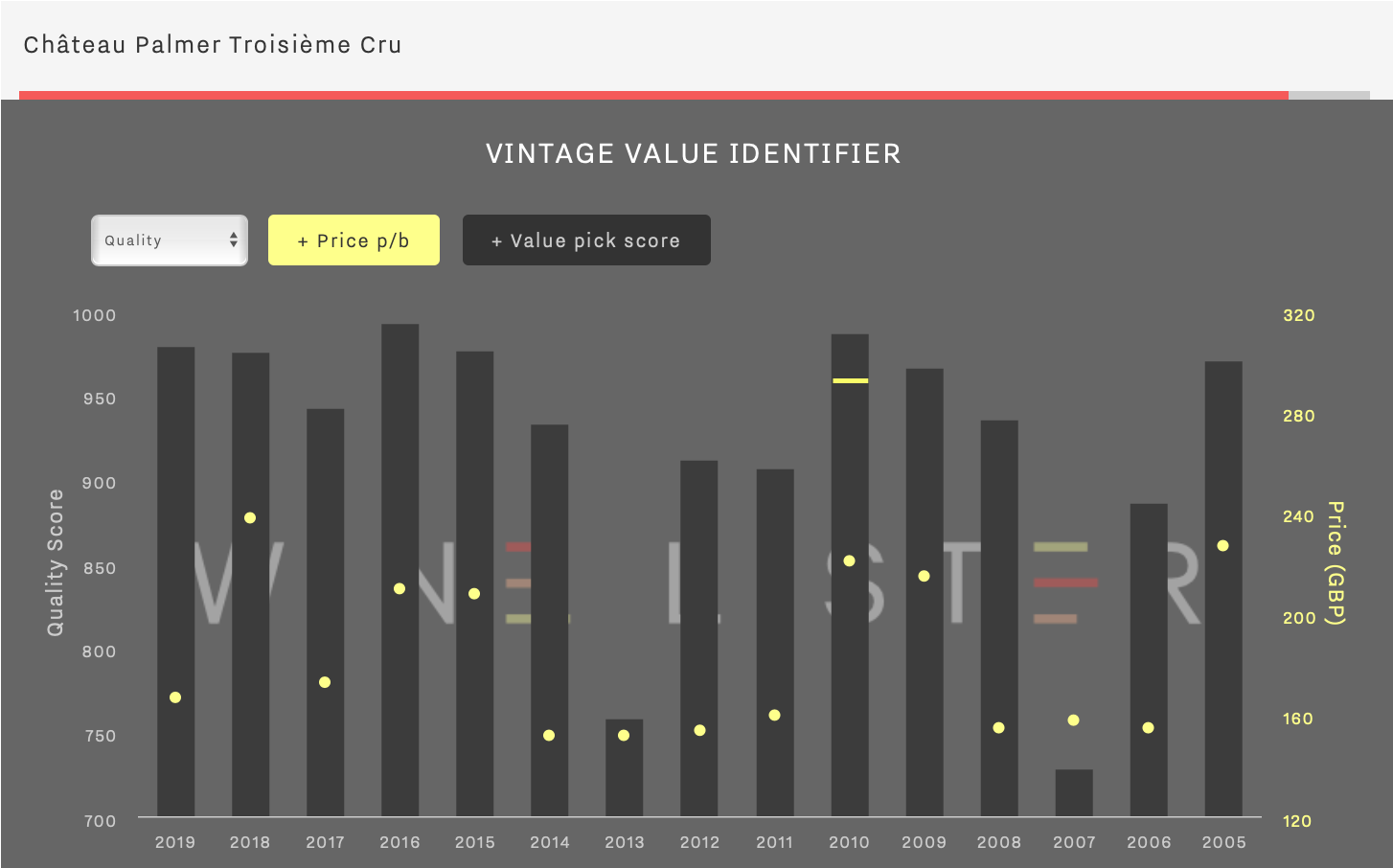
This is a bold hike up from Palmer 2010’s initial release price, however Director Thomas Duroux’s communication on production quantities and pricing as a direct result of the château’s uncompromising commitment to biodynamics and exceptional quality has prepared the market for it. The last few en primeur releases have set a solid scene for Palmer’s new strategy, and provide definitive proof that the château has outgrown the bounds of its classification.
We understand that immediate take-up for the N-10 release has been good, if not quite at the fast sell-out pace of en primeur. That is not the objective here – Duroux is confident that this ex-château stock will satisfy demand in the mid-term.
Indeed, even at its higher price, Palmer 2010 remains a Wine Lister MUST BUY.
If 2020 has given any gift at all, it would be time at home, which many have used to read more, and learn new things on topics familiar and foreign. Today’s blog helps you discover the unique stories behind some of the world’s most recognisable wines. Read on below to discover beyond the label of these notable names.
Krug – Cracking the code
Beyond its reputation as one of the most admired Champagne brands, Krug has also pioneered an industry innovation: Krug iD. Since 2011, a six-digit “identification code” has been printed on the back label of every Krug bottle. Scanning the code with a smartphone gives drinkers access to the unique story of the individual bottle, including a vintage report, as well as offering food pairing suggestions, and recommendations for its storage and serving.
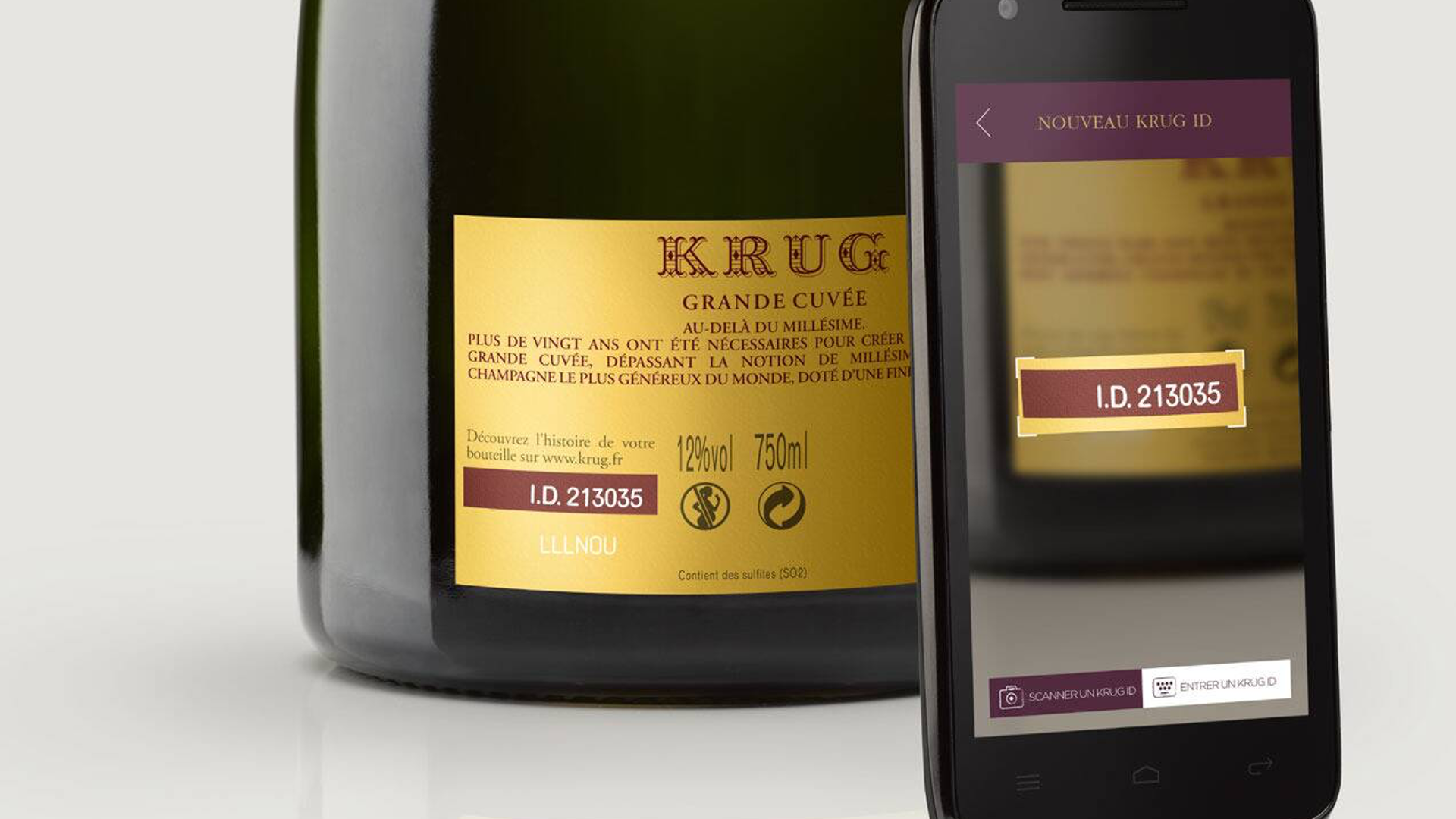 Photo credit: lvmh.com
Photo credit: lvmh.com
Aside from its technical innovation, the quality of Krug is simply undeniable. The latest NV Krug Brut Grand Cuvée (168ème Édition) achieves MUST BUY status, and receives a score of 19/20 from Wine Lister partner critic, Jancis Robinson, who notes a “remarkable acidity underpinned by great depth of flavour and beautiful balance on the finish”. It is available to purchase by the bottle from Crump, Richmond & Shaw Fine Wines for £133 (in-bond).
Cheval Blanc – Cultivation experimentation
Saint-Emilion superstar, Cheval Blanc, has illustrated significant long-term investment in its viticulture in recent years. Initiated by Managing Director, Pierre Lurton, the estate has conducted countless soil analyses, viticultural experiments, and regular phenological surveys to establish the best grape variety for each of its three different terroirs (gravel over clay, deep gravel, and sand over clay). Experiments have tested each possible variation of soil type for the Bordeaux varietals used in Cheval Blanc – 52% Cabernet Franc, 43% Merlot, and 5% Cabernet Sauvignon – to establish which combination delivers the best quality of fruit. Indeed, the château found its plot of sandy terroir to be particularly well suited to Cabernet Franc, providing a reference point for the best that can be achieved with the grape in Bordeaux.
Released en primeur in July this year, the 2019 Cheval Blanc was awarded 18 points from Jancis Robinson, who describes it as “beautifully poised on the palate with a density of fruit and silky texture of finely matted tannins. Pure, seductive and persistent”. It can be bought by the case of six for £2,400 (in-bond) from Farr Vintners.
Bond – Truth in terroir
With grapes sourced from select hillside plots across Napa Valley, Bond’s portfolio of Cabernet Sauvignon-based wines aims to reflect each wine’s specific sense of place. The estate owns five sites featuring some of the region’s best terroirs, and has dedicated its viticultural practice to preserving the best expression of its individual plots; Melbury, Pluribus, Quella, St. Eden, and Vecina.
The fruit from each site is vinified separately, while winemaking procedures are kept the same across all of the Bond wines in order to honour terroir differences. The Vecina vineyard, for instance, sits on volcanic soil at between 221 and 330 feet above sea level, causing a thermal amplitude of cool nights and hot afternoons, which renders its wines complex and layered, with concentrated tannins. The 2015 Bond Vecina was awarded 97 points from Wine Lister partner critic, Antonio Galloni (Vinous), who indeed describes it as “super-expressive. A big, dense wine, the 2015 possesses stunning richness and dimension”. It is available by the bottle for £443 (in-bond) from Fine+Rare Wines.
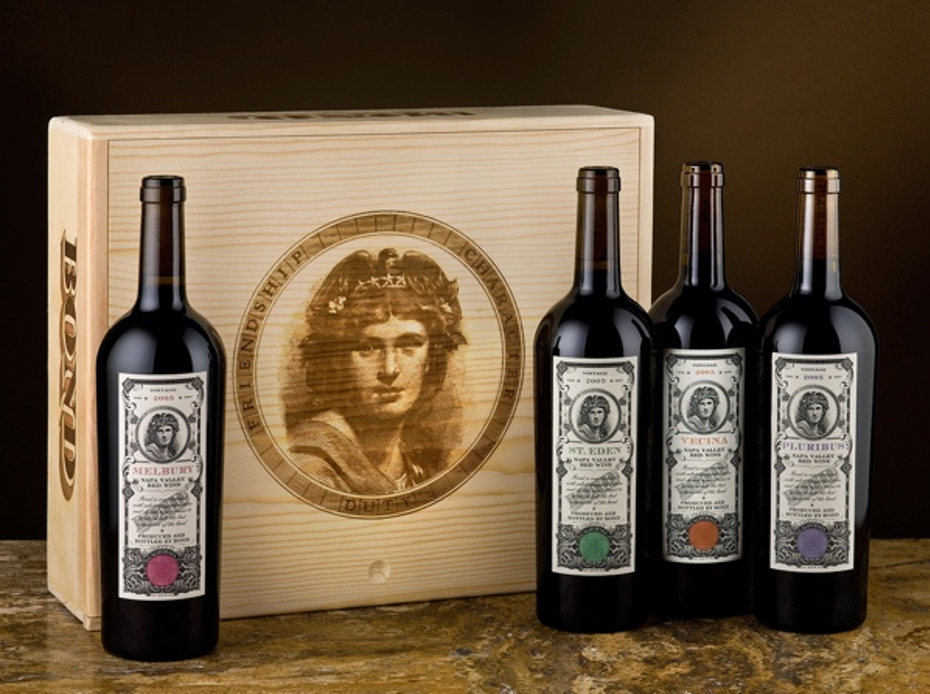 A line-up of Bond wines, that communicate the differences in the estate’s Napa Valley sites.
A line-up of Bond wines, that communicate the differences in the estate’s Napa Valley sites.
Ornellaia – An artist’s interpretation
Outside its global renown as a reference for quality in Tuscany, Ornellaia also stands out for its own special label tradition. Established in 2006, the estate’s annual artist program, Vendemmia d’Artista, commissions a new artist each year for the creation of the limited-edition label, inspired by a single word chosen by winemaker, Axel Heinz, to capture the essence of the new vintage. The latest release (2017) was named “Solare” due to the especially hot growing season, in which both the Cabernet Sauvignon and Cabernet Franc grapes were harvested as early as August for the first time in history. This inspired contemporary artist, Tomás Saraceno’s label design (below).
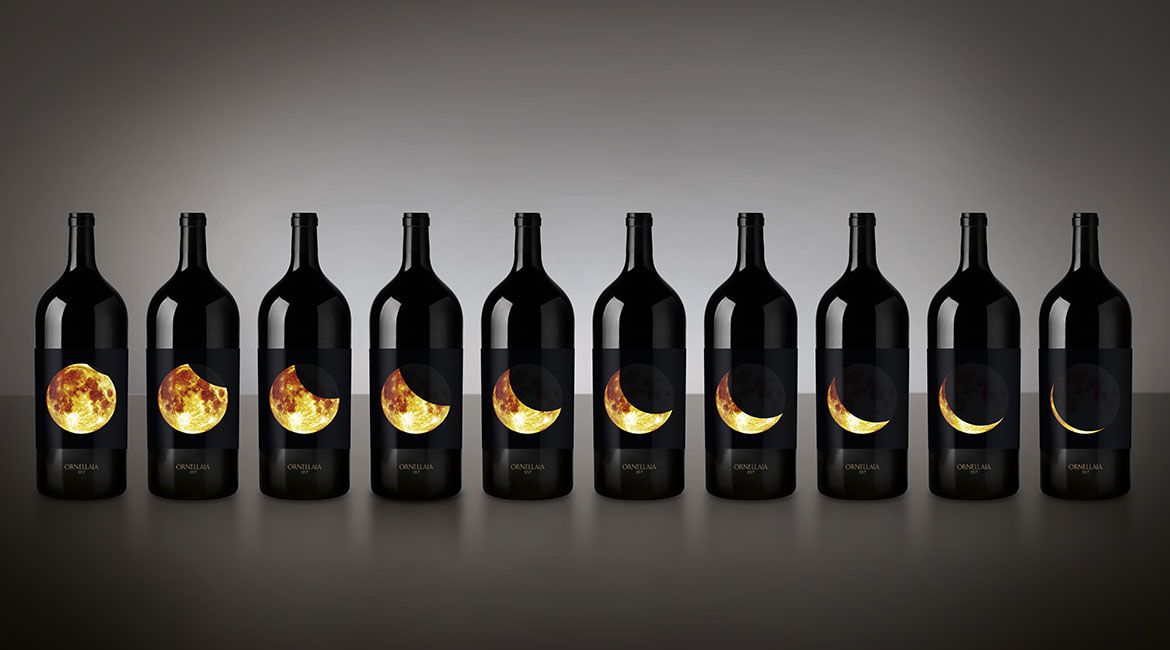 Photo credit: ornellaia.com
Photo credit: ornellaia.com
Awarding the Ornellaia 2017 97 points, Wine Lister partner critic, Antonio Galloni describes it as “sumptuous and racy, as Ornellaias from warmer years tend to be, but it is not at all heavy or overdone. In a word: superb!”. The vintage can be bought by the case of six from Justerini & Brooks for £765 (in-bond).
The four above-mentioned wineries provide just a small handful of innovative and engaging examples of how to make a wine stand out from the crowd. Wine Lister has launched a dedicated PR and communications service in order to help more producers do the same on the UK market. To find out more, please contact us at team@wine-lister.com.
Amid the flurry of releases from La Place de Bordeaux during September, an exciting development is said to be afoot from a wine grown on home turf.
We understand that Lafite 2018 – released last spring en primeur and currently still only available to purchase as such – will be bottled next year in special, 150 year anniversary bottles, complete with one-off anniversary labels.
The current average market price of Lafite 2018 is £533 per bottle (in-bond)*. Special bottlings typically induce significant price rises, particularly for Bordeaux first growths.
Mouton 2000’s special, gold-engraved bottle is priced almost four times higher than the average of Mouton’s recent back vintages (£1,558 vs. £398).
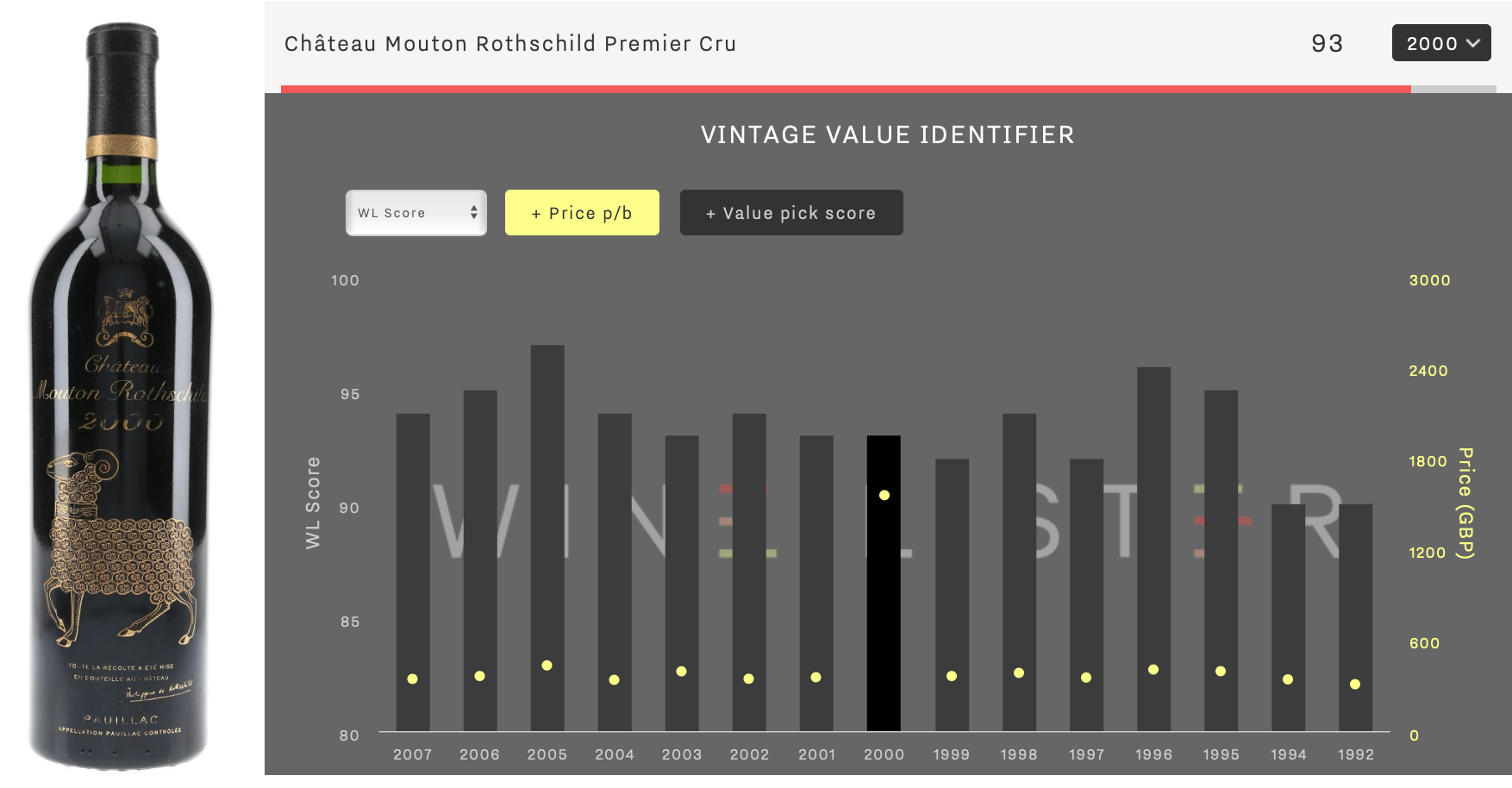
Similarly, the price of Margaux 2015, whose special bottle features a black label in memory of its winemaker, the late Paul Pontallier, has risen 64% since the commemorative bottling was announced.
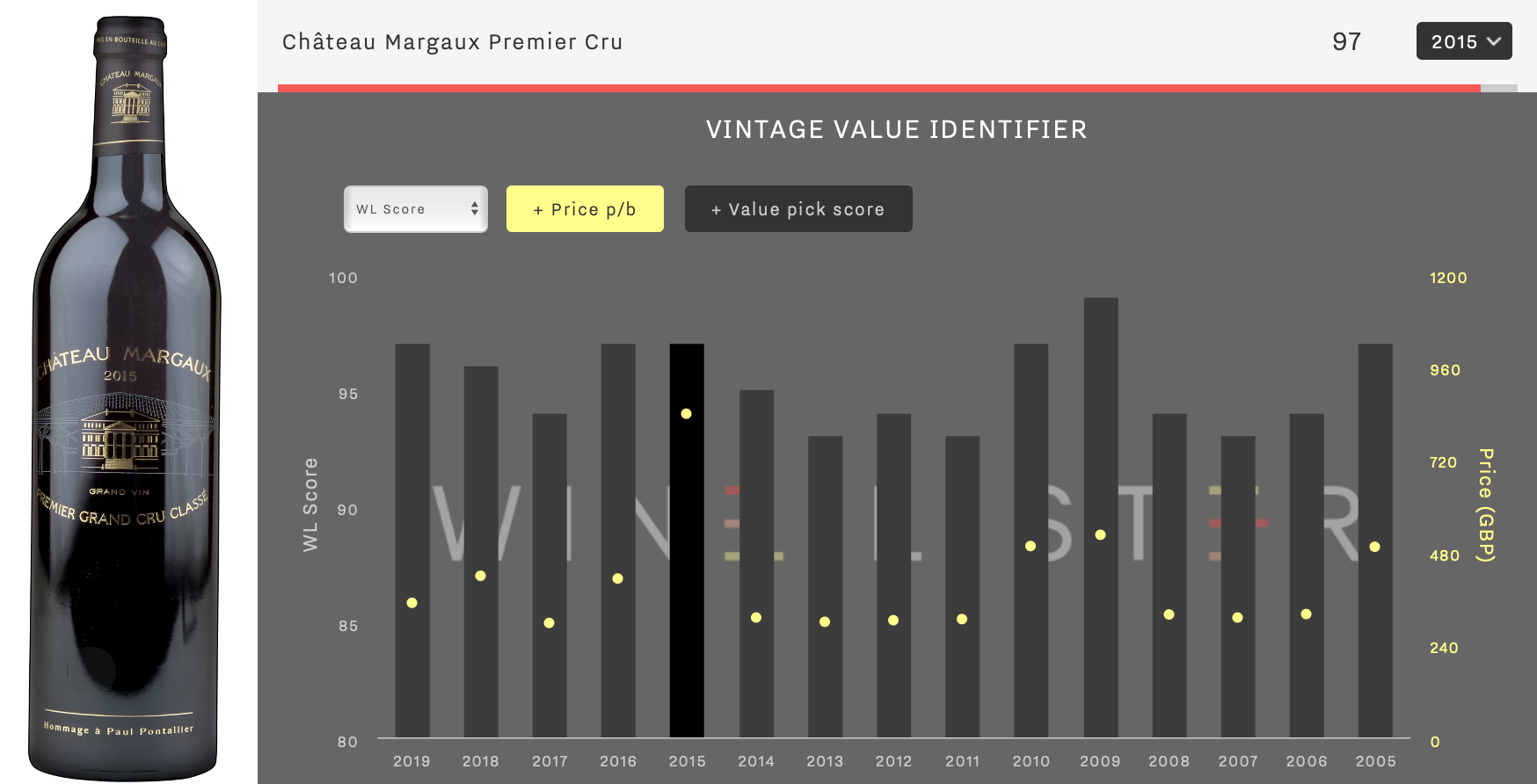
Prices of any remaining Lafite 2018 in the global marketplace are therefore poised to increase between now and the actual bottling of the wine, at which time we understand a small parcel of further, physical stock could be released by the château (presumably at a sizeable premium).
Lafite 2018 is currently an absolute MUST BUY.
*on date of publication, Thursday 17th September 2020













 Photo credit: lvmh.com
Photo credit: lvmh.com A line-up of Bond wines, that communicate the differences in the estate’s Napa Valley sites.
A line-up of Bond wines, that communicate the differences in the estate’s Napa Valley sites. Photo credit: ornellaia.com
Photo credit: ornellaia.com
